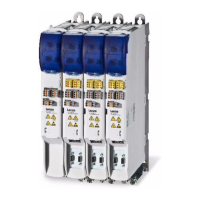5 Motor control & motor settings
5.8 Setting the motor parameters for the servo control
83
Lenze · i700 servo inverter · reference manual · DMS 3.0 EN · 06/2016 · TD06
_ _ _ _ _ _ _ _ _ _ _ _ _ _ _ _ _ _ _ _ _ _ _ _ _ _ _ _ _ _ _ _ _ _ _ _ _ _ _ _ _ _ _ _ _ _ _ _ _ _ _ _ _ _ _ _ _ _ _ _ _ _ _ _
After the parameters have been extracted from the impedance, they are checked for consistency
with the required rated values. If an inconsistent parameter set is detected, is this an indication of
faulty rated values on the nameplate.
Preconditions for the execution
• The synchronous motor must be able to rotate freely.
• The asynchronous motor may be firmly braked.
• The servo inverter is free of errors and is in the "Switched on
" device status.
• The motor parameters listed in the following table are excluded from the automatic
determination and must therefore be adapted to the motor used (see motor nameplate before
the determination.
Response of the motor during the execution
• A DC current is superimposed over the identification current that keeps the motor idling. After
the controller enable, the shaft will adjust once, which is irrelevant to measurement though.
• With asynchronous motors, slight rotations might possibly occur. Their influence on the
measurements is, however, not worth mentioning.
Object Name
Axis A Axis B
0x6075 0x6875 Motor rated current
(The current amount for the procedure is derived from this specification)
0x2C01:2
0x3401:2 Motor: Stator resistance
(Default setting is used as starting value for the automatic determination.)
0x2C01:4
0x3401:4 Motor: Rated speed
0x2C01:5
0x3401:5 Motor: Rated frequency
0x2C01:6
0x3401:6 Motor: Rated power
0x2C01:7
0x3401:7 Motor: Rated voltage
Note!
• In case of uncertainties, the measurement should be repeated several times to check
if the results for the stator resistance, the leakage inductance of the stator and the
rotor resistance differ widely. This should not be the case.
• The mutual inductance and the cos(ϕ) values are not that important for the
diagnostics, because they are strongly non-linear.

